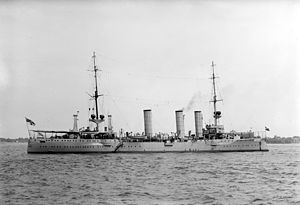 SMS Stettin in 1912
| |
| History | |
|---|---|
| Name | Stettin |
| Namesake | Stettin |
| Builder | AG Vulcan, Stettin |
| Laid down | 1906 |
| Launched | 7 March 1907 |
| Commissioned | 29 October 1907 |
| Stricken | 5 November 1919 |
| Fate | Ceded to Britain 1920, scrapped in 1921–1923 |
| General characteristics | |
| Class and type | Königsberg-class light cruiser |
| Displacement | |
| Length | 115.3 m (378 ft) |
| Beam | 13.2 m (43 ft) |
| Draft | 5.29 m (17.4 ft) |
| Installed power |
|
| Propulsion |
|
| Speed | 24 knots (44.4 km/h; 27.6 mph) |
| Range | 5,750 nautical miles (10,650 km; 6,620 mi) at 12 knots (22 km/h; 14 mph) |
| Complement |
|
| Armament |
|
| Armor |
|
SMS Stettin ("His Majesty's Ship Stettin")[a] was a Königsberg-class light cruiser of the Kaiserliche Marine (Imperial Navy). She had three sister ships: Königsberg, Nürnberg, and Stuttgart. Laid down at AG Vulcan Stettin shipyard in 1906, Stettin was launched in March 1907 and commissioned into the High Seas Fleet seven months later in October. Like her sisters, Stettin was armed with a main battery of ten 10.5 cm (4.1 in) guns and a pair of 45 cm (18 in) torpedo tubes, and was capable of a top speed in excess of 25 knots (46 km/h; 29 mph).
In 1912, Stettin joined the battlecruiser Moltke and cruiser Bremen for a goodwill visit to the United States. After the outbreak of World War I, Stettin served in the reconnaissance forces of the German fleet. She saw heavy service for the first three years of the war, including at the Battle of Heligoland Bight in August 1914 and the Battle of Jutland in May – June 1916, along with other smaller operations in the North and Baltic Seas. In 1917, she was withdrawn from frontline service and used as a training ship until the end of the war. In the aftermath of Germany's defeat, Stettin was surrendered to the Allies and broke up for scrap in 1921–1923.
Cite error: There are <ref group=lower-alpha> tags or {{efn}} templates on this page, but the references will not show without a {{reflist|group=lower-alpha}} template or {{notelist}} template (see the help page).